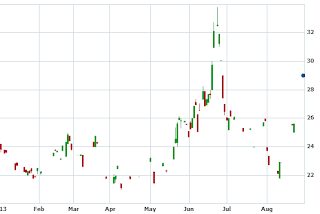Monday, September 23, 2013
DUST Update
After a big down day three trading days ago DUST has had a big climb making it a possibility that we will see a second test of the trendline somewhere around 40.
Saturday, September 21, 2013
My thoughts on QE

I thought I'd do something different and post my thoughts on QE, what it is and how it effects prices of stocks and bonds. It will be a round up of my thoughts after reading up on the subject in the blogosphear and some links where these thoughts are expressed more in detail.
What QE is
What QE is
QE is an
asset swap. Under the current scheme FED gets treasuries and MBS’s (Mortgage backed securites) and in exchange the banking
system gets excess reserves and cash. For banks it means more
liquidity but lower yielding assets. The FED gets added income but added risk.
What QE isn't
QE is not printing money that goes to buying stocks.
Why Quantitative Easing Isn't Printing Money
QE only results in FED reserves and cash, so far about 80% of QE is new reserves, 20% is new cash.
http://www.washingtonsblog.com/2013/06/81-5-of-money-created-through-quantitative-easing-is-sitting-there-gathering-dust-instead-of-helping-the-economy.html
QE will not cause credit expansion because reserves are not used for making new loans
http://pragcap.com/sp-says-repeat-after-me-banks-cannot-and-do-not-lend-out-reserves
Is QE inflationary?
Yes but only marginally. The value of money is determined by the fundamental value (Assets of the FED) plus its liquidity value (The premium over its fundamental value for any asset that is liquid). QE drives out the liquidity value of money and makes its value close to its fundamental value.
For more on understanding fundamental value and liquidity value of assets:
http://jpkoning.blogspot.se/2013/08/google-as-monetary-superpower-parable.html
Do QE cause stocks to rise in price?
What QE isn't
QE is not printing money that goes to buying stocks.
Why Quantitative Easing Isn't Printing Money
QE only results in FED reserves and cash, so far about 80% of QE is new reserves, 20% is new cash.
http://www.washingtonsblog.com/2013/06/81-5-of-money-created-through-quantitative-easing-is-sitting-there-gathering-dust-instead-of-helping-the-economy.html
QE will not cause credit expansion because reserves are not used for making new loans
http://pragcap.com/sp-says-repeat-after-me-banks-cannot-and-do-not-lend-out-reserves
Is QE inflationary?
Yes but only marginally. The value of money is determined by the fundamental value (Assets of the FED) plus its liquidity value (The premium over its fundamental value for any asset that is liquid). QE drives out the liquidity value of money and makes its value close to its fundamental value.
For more on understanding fundamental value and liquidity value of assets:
http://jpkoning.blogspot.se/2013/08/google-as-monetary-superpower-parable.html
Do QE cause stocks to rise in price?
Stocks by empirical observation have risen from QE, at least initially. Does QE drive other money to buy
stocks? Before QE the private sector owned more treasuries and MBS’s that yeilded higher
returns than FED reserves. To get the same yeild in total after QE a rebalancing must occur to assets width higher yields when so much assets are locked in low yielding/low risk reserves. This might be one reason more stocks will be demanded.
What effect do QE have on bonds?
By empirical observation QE puts downward pressure on bonds.
http://seekingalpha.com/article/1447181-to-sustain-the-rally-the-fed-should-start-tapering-now
What's a possible explanation? The only one I've seen so far is that QE appart from being mildly inflationary, raises inflation expectations. Then this reaction in the bond market would be irrational. Another reason could be the same as the one for stocks. The private sector wants higher yeilding assets than bonds since they've just been forced to hold plenty of low yielding assets in the form of reserves.
Conclusion
QE is an asset swap, its affect on overall inflation is small and decreasingly effective the more it is done. Its effect on stocks and bonds might be that it drives banks into rebalancing their non reserve assets to higher yielding assets.
Friday, September 20, 2013
EDC
Another possible touching of trendline in a megaphone pattern. Again it's a non reversed pattern. I'm not sure about these. They seem just a little far fetched. Touching the trendline seems to occur a little too often recently but maybe it is just a sign of where we are in the market overall. And I don't think the supprt trendline is symmetrical enough. there is room for it to move up towards 35. I might make a bet if it goes a little further.
DRN
I usually like my megaphone patterns on reversed charts (meaning the megaphone pattern turns up when you reverse the chart from the underlaying market as is done in Bear ETFs) but recently I've traded the megaphone pattern in FXI that is a non reversed chart and now I think DRN looks tempting as a touching of trendline play.
Thursday, September 19, 2013
Tyler Technologies (TYL) Update
I started this blog to follow the blow off top pattern, then I found the more predictable and profitable megaphone pattern. These are the only two patterns I search for. It has been almost only megaphone pattern charts lately so it feels nice to get back to a pretty little blow off chart. So here is an old short recommendation (TYL) steaming ahead above 80. I am short from 73.5
Obviously I was too early. So how about the long term chart?
Obviously I was too early. So how about the long term chart?
Thankfully it shows that TYL is in lala-land. It can go up further but what is encouraging is that it is following the path of an unsustainable move. The short position remains and I hope to see a profit in the not too distant future. It is also likely I will add to the short position if the unsustainable path continues. It is my belief that blow off tops are one of the most predictable patterns, and yet one of the simplest patterns to spot. There is less traders making decisions based on the long term charts then there are traders and investors making decisions based on the increasingly larger stream of incoming fundamental good news. But in stock trading fundamentals don't matter because unless it is fundamentals known by just a few the fundamentals are already priced in.
China (FXI) Update
Despite the big moves everywhere nothings really changed regarding the outlook for FXI. It has now touched the megaphone pattern trendline two times. This should be a very good short candidate from here.
INP and DUST update
I try not to care about macro events and FED decisions etc. I wan't to be purely technical. So I just conclude that for whatever reason a bunch of charts had an interesting day yesterday. In the case of INP it completed a downward move comparable to the last leg up. So what's next? While it's not possible to know the exact shape of the supprting floor for the megaphone pattern of INP it can at least be estimated to be somewhere in either of the two concave lines drawn on the chart below. (The chart is 3X reversed) It's possible that the momentum will push the chart even lower put pretty soon we should see a bounce and a crawl up towards the trendline. I pointed out two possibles scenarios. Both are the same move, it's just a matter of scale. The point is that soon a bounce towards the trendline should be expected. It could be played both on the up move before the trendline is reached and on the downmove after.
Regarding DUST, a bounce towards the trendline is what just happened. But personally I got greedy and wanted to get in at the last minute so except for an initial small position I didn't make much money on this latest move down. I thought the bounce would go just a little bit further up at the 40 level.
After this latest fall in DUST I don't have any read on what DUST is going to do next. The megaphone pattern is finished and I have to greatfull that it was a predictable and profitable pattern. There could be a second attempt towards the trendline but it's nothing I'm going to bet on. If there is a second attemt for the trendline it would be as a new megaphine pattern starts. It's possible that happens, especially considering how big the latest megaphone pattern was. Then DUST is very tradable again, but for not I'm just going to keep my small short position at least for a few days longer and continue to look for megaphone patterns in general.
Regarding DUST, a bounce towards the trendline is what just happened. But personally I got greedy and wanted to get in at the last minute so except for an initial small position I didn't make much money on this latest move down. I thought the bounce would go just a little bit further up at the 40 level.
After this latest fall in DUST I don't have any read on what DUST is going to do next. The megaphone pattern is finished and I have to greatfull that it was a predictable and profitable pattern. There could be a second attempt towards the trendline but it's nothing I'm going to bet on. If there is a second attemt for the trendline it would be as a new megaphine pattern starts. It's possible that happens, especially considering how big the latest megaphone pattern was. Then DUST is very tradable again, but for not I'm just going to keep my small short position at least for a few days longer and continue to look for megaphone patterns in general.
Tuesday, September 17, 2013
Exiting India ETF and exits in general

The megaphone pattern is a series of increasingly larger spikes, usually set on a concave supporting floor. Now please excuse the artistic quality of the illustration you are about to see.
Once the chart breaks the supporting floor it tends to look for a test of this floor from below, smash in to it and head further down. My preferable way to play the megaphone pattern is to short what looks to be a big spike.
A typical example of this is the post i did August 28. On ordinary stocks and ETFs I search for the megaphone pattern by reversing charts and magnifying the daily movements 3X so the chart mimics the 3X daily leveraged ETFs where the megaphone pattern can be found frequently. So 20 days later the 3X reverse chart of the INP looks like this:
So the question for finding the right exit is where is the chart in relation to the support floor.
Are we here?
Or rather here?
I would argue something close to the latter since the floor line is more concave and symmetric. So there is a high likelyhood the support floor has been broken and the latest spike has almost gone all the way down as it first had spiked up. There is still a high likelyhood that the symmetry of the spike will be completed and that it will move down to the same level as it started before moving up. There is also a high likelyhood that this chart will test the support floor sooner or later. With this in mind we have definetly entered the exiting zone of this ETF. While a few more percents might be made I took the money today and decided to exit INP with a decent profit. But keep in mind there might soon be a second chance to make a trade if there is a test of the support floor coming.
Thursday, September 12, 2013
Thursday Night Update
First of all I had to withdraw 17.6 % of total portfolio value today because of an upcoming apartment purchase. It's not an investment, it's for a place to live.
 |
| (I wish) |
INP has, as predicted, had a strong comeback and might be due for some resistance or even another spike down.
FXI has, as predicted, started to move down.
Wednesday, September 11, 2013
China (FXI) Update
FXI is getting increasingly vertical near the testing of resistance of a previous megaphone pattern floor. I will continue to add to the short position today if the turn doesn't come. Allocation of portfolio will creep up to 25-30%.
DUST Accumulation
I'm rethinking my DUST accumulation plan. I think the likelyhood of DUST creeping up towards the 40 level is pretty high, which was my original thought. But because of the hard to borrow situation of DUST stocks I am going to risk not accumulating so many short positions between the 30 to 38 level and increase the volume around the 40 level instead. The risk compared to the original plan is that I won't accumulte any large position if it turns before the 40 level. The upside is that I don't risk as many stocks in a forced buy in if they are not available for short sale any longer. The other possible gain is offcourse that I will accumulate at a higher price the further I wait.
Monday, September 9, 2013
The stars and the moon are in line over the Chineese continent

Well maybe not, but the signal I'm seing is that in China (FXI) a megaphone pattern is testing a broken trendline. That usually doesn't end well, so I'm putting some money behind this guess. for now a portfolio allocation of about 20% right away. I'm both short FXI and long FXP. There is not much room for accumulation at this point because the chart seems near the trendline. Maybe the price could still move up a few percent and I might increase the size of the bet but I think it is pretty close to a turn. One thing that makes me a little cautius though is that I usually only see the megaphone pattern in reverse charts, and this is a long chart. But the pattern looks pretty clear so I'm taking my chances with this one but I probably won't hold on to it for long.
 |
| FXI |
Saturday, September 7, 2013
CONN
Thursday, September 5, 2013
Problems for my DUST short sell plan
Surprisingly there seems to be a shortage of stocks available for short selling in DUST. I didn't think this would happen considering the large trading volumes in DUST lately. I will have to adapt and find another way to accumulate a position like the one I was going to take in DUST. The alternative is to go long gold miner ETFs or even individual gold miner stocks. I could also play this bounce in gold or silver ETFs. Anyway the next trigger for adding to positions isn't until DUST is in the 33 zone and we are not quite there yet.
Monday, September 2, 2013
Megaphone Pattern in TUR
I completely missed to look at Turkey. There has been so much action elsewhere in emerging markets and it didn't show up on the scanners but the chart looks interesting.
The 3X leverage inversed chart is up 400%. The timing on different markets in emerging markets may be different. Some might do an overshoot of the latest top while others are already moving down from the latest spike. When gold miners ETFs had already spiked, individual gold stocks where spiking several days after. If something similar happens in individual emerging market ETFs that would be an excellent opportunity for entering a position.
 |
| TUR (3X Inversed) |
Anatomy of the megaphone pattern (And pre-week update of interesting charts)
I would categorize the megaphone pattern into four different phases.
1. The building phase
When the chart already has performed one or two spikes and seems to be preparing for another one. This is not a phase I trade as it is not at all certain that a bigger spike will follow but it is the phase that raises awareness of possible future spikes coming.
Here are some current examples of charts in the building phase:
 |
| DRV |
 |
| BZQ |
 |
| EDZ |
 |
| SMK |
2. The spiking phase
When the chart is spiking in a megaphone pattern. This is the most tradable phase since it can be expected that a spike when done in the context of the megaphone pattern is not sustainable for a long time.
Currently I can't find any chart in the spiking phase.
3. Coming down from a spike
When the chart is coming down from a previous spike in the megaphone pattern. This is a phase that when done right a position should already be taken. When the spike has come down sufficiently (a subject that needs further discussion) it is time to exit the position.
Here is a chart coming down from a spike:
 |
| INP (3X Reversed) |
4. Testing a broken megaphone pattern trendline
A megaphone pattern has a usually concave support floor that acts as resistance once it gets broken. The is a second tradable opportunity in the megaphone pattern since that trendline has a high likelyhood to hold. These trandlines can also come at multiple levels.
Here are some charts that have broken the megaphone pattern trendlines and have either tested or are creeping up to test the trendline, or both.
 |
| DUST |
 |
| KOLD |
 |
| FXP |
 |
| BDD |
Subscribe to:
Posts (Atom)


















